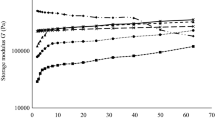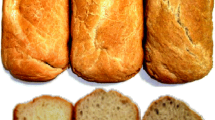Abstract
Bran dusters are used in the wheat flour milling process to increase flour extraction rate. Chemical, rheological and bread characteristics of bran duster flours (BDR1, BDR2, BDR3) and straight run flour (SRF) obtained from two commercial roller flour mills were analyzed. Important chemical characteristics such as ash, dry gluten content, sedimentation value, damaged starch and falling number of bran duster flours were determined. Rheological behavior was tested using farinograph and alveograph equipments. The results showed an increase in ash, dry gluten content and Zeleny’s sedimentation value for bran duster flours compared to SRF. Rheological characteristics indicated higher farinograph dough development time and stability values for bran duster flours. Alveograph characteristics indicated higher extensibility and lower elasticity values for bran duster flours. Over all quality score of bread for BDR1 from A and B roller flour mills ranged from 73.4 to 74.7, BDR2 (79–81.8), BDR3 (69–70.4) as against SRF (85.4–86.3).



Similar content being viewed by others
References
AACC (2000) American association of cereal chemists. Approved methods St. Paul, MN, AACC
Aitken TR, Geddes WF (1938) The effect of flour strength of increasing the protein content by addition of dried gluten. Cereal Chem 15:181–196
Aitken TR, Geddes WF (1939) The relation between protein content and strength of gluten enriched flours. Cereal Chem 16:223–231
Banu I, Stoenescu G, Ionescu V, Aprodu I (2010) Physicochemical and rheological analysis of flour mill streams. Cereal Chem 87(2):112–117
Bass EJ (1988) Wheat flour milling. In: Pomeranz Y (ed) Wheat: chemistry and technology (Vol. 2), 3rd edn. American Association of Cereal Chemists, St Paul, pp l–68
Dornez E, Gebruers K, Wiame S, Delcour JA, Courtin CM (2006) Insight into the distribution of arabinoxylans, endoxylanases, and endoxylanase inhibitors in the industrial wheat roller flour mill streams. J Agric Food Chem 54:8521–8529
Dube R, Indrani D, Sidhu JS (1987) Flour mill streams. I. Physico-chemical and rheological characteristics. Indian Miller 1:17–34
Hinton JJC (1959) The distribution of the ash in wheat kernel. Cereal Chem 36:19–31
Holas J, Tipples KH (1978) Factors affecting farinograph and baking absorption, I Quality characteristics of flour streams. Cereal Chem 55:637–652
Indrani D, Prabhasankar P, Rajiv J, Venkateswara Rao G (2003) Scanning electron microscopy, rheological characteristics and bread baking performance of wheat flour dough as affected by enzymes. J Food Sci 68:2804–2809
Kent NL (1966) Subaleurone endosperm cells of high protein content. Cereal Chem 43:585–589
Kruger JE, Tipples KH (1980) Relationship between falling number, amylograph viscosity and alpha amylase activity in Canadian wheat. Cereal Res Comm 8:97–105
MacMasters MM, Bradbury D, Hinton JJC (1964) Microscopic structure and composition of the wheat kernel. In: Hlynka I (ed) Wheat: chemistry and technology. American Association of Cereal Chemists, St Paul, pp 55–110
Pfeifer VF, Vojnovich C, Anderson RA (1958) Vital wheat gluten by drum drying. Cereal Chem 35:458–468
Posner ES, Hibbs AN (2005) Wheat flour milling (2nd edn) American association of cereal chemists St. Paul, MN, USA, (Chapter 5)
Rani KU, Prasad Rao UJS, Leelavathi K, Haridas Rao P (2001) Distribution of enzymes in the wheat flour mill streams. J Cereal Sci 34:233–242
Sakhare SD, Inamdar AA (2011) The cumulative ash curve: a best tool to evaluate complete mill performance. J Food Sci Tech. doi:10.1007/s13197-011-0549-z
Steel RGD, Torrie JH (1960) Principles and procedures of statistics. McGraw-Hill, New York
Symons SJ, Dexter JE (1997) Aleurone and pericarp fluoresce as estimators of mill stream refinement for various Canadian wheat classes. J Cereal Sci 23:73–83
Ziegler E, Greer EN (1978) Principles of milling. In: Pomeranz Y (ed) Wheat chemistry and technology (Vol. 2), 3rd edn. American Association of Cereal Chemists, St Paul, pp l15–199
Author information
Authors and Affiliations
Corresponding author
Rights and permissions
About this article
Cite this article
Sakhare, S.D., Indrani, D., Inamdar, A.A. et al. Chemical, rheological and bread making characteristics of bran duster flours from roller flourmills. J Food Sci Technol 51, 2699–2705 (2014). https://doi.org/10.1007/s13197-012-0770-4
Revised:
Accepted:
Published:
Issue Date:
DOI: https://doi.org/10.1007/s13197-012-0770-4




